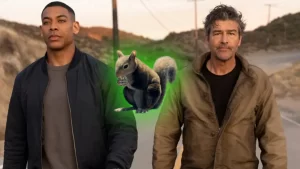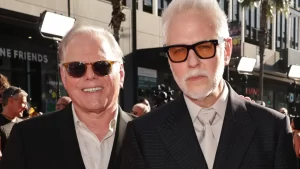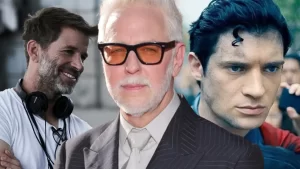“X-Trap”ulating Expectations
A Film Review of Green Lantern
By: Lawrence Napoli
 Whilst ruminating over the significance of the summer Hollywood film blitz of 2011, I wondered if it would be remembered for its impressive lineup or reviled for its lost potential. Trends at the box office and a healthy collective of critics would have you believe in the latter, as no film has been able to maintain the level of ticket sales (and produce apparent quality) to reach the $300 million dollar threshold, yet. I do not think that the American viewing public truly has an appreciation for the extremely unique concentration of big name productions that relentlessly pepper our entertainment palates week after week, like body blows from Iron Mike. The sheer volume of these licenses and the quality of their source material is worthy of its own case study entitled: “Why So Much? Why Now?” Never before has so much been expected from so many films released in so few months. And therein lies the key word to understanding films like Green Lantern and the summer of 2011 as a whole: expectation.
Whilst ruminating over the significance of the summer Hollywood film blitz of 2011, I wondered if it would be remembered for its impressive lineup or reviled for its lost potential. Trends at the box office and a healthy collective of critics would have you believe in the latter, as no film has been able to maintain the level of ticket sales (and produce apparent quality) to reach the $300 million dollar threshold, yet. I do not think that the American viewing public truly has an appreciation for the extremely unique concentration of big name productions that relentlessly pepper our entertainment palates week after week, like body blows from Iron Mike. The sheer volume of these licenses and the quality of their source material is worthy of its own case study entitled: “Why So Much? Why Now?” Never before has so much been expected from so many films released in so few months. And therein lies the key word to understanding films like Green Lantern and the summer of 2011 as a whole: expectation.
One of the biggest reasons Green Lantern, the film, has been generating so much negative criticism is a direct result of Herculean expectations established by recent film work in this particular subset of the action/adventure genre. The Chris Nolan Batman franchise, and to a somewhat lesser extent Iron Man, have raised the bar for superhero films to expect high performance levels from its cast, generate acute detail to the main character’s development, a dedication to the story’s drama and some significant social commentary to give the spectacle some perspective. But Green Lantern is not a Chris Nolan production, and Ryan Reynolds is not Robert Downey Jr. Does that mean this film is complete garbage? Not a chance. Does it mean this film is not on the same level as the gold standards? Unfortunately, yes. That’s ok because this summer has been littered with this exact caliber of superhero film: ample entertainment, but coming well short of that “it” factor.
I was very disappointed in yet another superhero origin story falling prey to overambitious screenwriters compelled to include anything and everything relevant to the main character, in a film designed to merely establish said character. It is a thought process first introduced to filmmaking by Bryan Singer which I will refer to as “The X-Trap.” We must introduce X number of characters. We must incite X number of conflicts. We must include X number of Easter Eggs. If “X” is too high of a number, that leaves precious few minutes of screen time left for developing those characters, resolving those conflicts and allowing those Easter Eggs to maintain their status as story enhancements – and not become distractions. Perhaps “The X-Trap” is also applicable to the number of writers put in charge of generating a script. Green Lantern had four writers: Greg Berlanti, Michael Green, Marc Guggenheim and Michael Goldenberg. These writers included too much exposition, too many redundant characters, and paid too little attention to fully exploring Green Lantern’s most poignant theme: force of will can overpower the limitations of fear with a little help from courage. This screenplay is in serious need of emergency liposuction from Dr. 90210, stat!
I was very pleased with the performance of Ryan Reynolds as Hal Jordan, but it was not flawless by any stretch of the imagination. 50% of the blame goes back to the writing where I noticed a few scenes in the first half of the film that were specifically written as “Ryan Reynolds comedy” scenes as opposed to “Hal Jordan advancing the plot” scenes. 25% of the blame goes to casting, as I thought Reynolds obviously had Jordan’s physique and good looks, but nowhere close to his commanding demeanor. The last 25% of the blame goes to Reynolds himself because the man has made an incredibly lucrative career of playing smart a– characters in movies. As a result, he fails to really deliver moments in Green Lantern where seriousness and determination are the order of the day. [Please note: this is same exact concern I have for Chris Evans as Captain America] Where Reynolds succeeds is his ability to tap into some emotions he first dabbled with in Definitely, Maybe (2008) and The Proposal (2009): vulnerability. Reynolds may not have achieved Hal Jordan’s elitist attitude, but totally nails somber self-reflection in his failures, and it is in these moments where the audience falls in love with Hal Jordan; it’s what makes this character most human.
I was quite taken aback by the slut-free performance of Blake Lively. Any time a good looking woman stows the trash and whips up some class,is a time to celebrate, and this holds especially true in the real world, not just in Hollywood films. I understand Ms. Lively is merely playing out her assigned roles, but at some point, actors and actresses have to take some responsibility for choosing the same types of roles over and over again. Regardless, Lively delivers sophistication and respect for her character Carol Ferris, Hal Jordan’s love interest and “boss.” I would have preferred more screen time between her and Reynolds to expose a little more of the history and potential of their personal relationship – because they did have some good chemistry onscreen. Blake’s particular strength lies in her close-ups when she is speaking with Reynolds in a stern demeanor, and has an ability to make a faint smile at the end of conversations to indicate that her character is still in love with Jordan regardless of what he has become.
There were so many other “important” characters to the movie that they were all stereotypically one-dimensional at times, and then almost insulting to one’s intelligence at others. But I will not place the onus on the failure of these supporting characters on the actors themselves because they failed as a direct result of poor writing (PW) or poor casting (PC). Peter Sarsgaard as Hector Hammond (PW) would have yielded a better character had he actually been the main antagonist. Mark Strong as Sinestro (PW) might have been a better mentor if he had more than 2 minutes of screen time to do so. Angela Bassett as Amanda Waller (PW) would have showcased her stellar command had she been written as the director of Cadmus, as opposed to some random scientist. Tim Robbins as Senator Hammond (PC) looked as uncomfortable in every scene as I was watching him. Green Lantern is not his type of movie, and he clearly did not belong because he was probably a last minute add-on for some perceived credibility boost.
As for those visual effects, well, they were quite excellent. The collaboration between visual effects companies SPI, Pixomodo, Peerless, Prime Focus, Peanut FX, Trixter, Rising Sun and Hyrdaulx created exquisitely cool ring powers and light constructs, extremely detailed alien races and quite epic wide shots during scenes in space (wide shots on Earth just didn’t have the same impact). The CG work had to be great because almost all of the action in Green Lantern required full CG sequencing. Sure, the character design for Parallax is absolutely atrocious, but there is a specific reason why we don’t see the cool, yellow, massive, space cockroach configuration us comic geeks are used to. Once you buy the expository explanation, it becomes far easier to admire the work that went into even its design. I only found minor issues with some of the CG design for the fully fabricated scenes in the film. I wasn’t fond of accentuating the elderly haggardness of the Guardians of the Universe, and I thought the planet OA was far too dark and needed much more green everywhere.
Just because Green Lantern, the character, is coming off Blackest Night and Brightest Day in the comic books, it does not mean he is due to have an equally epic impact in his first foray on film. Green Lantern is an origin story that desperately attempted to channel Iron Man’s success, but could not retain a simple story favoring excessive character add-ons and subplots. In addition, the post credits epilogue has no explanation for its inclusion other than the tried and true rationale for all things inexplicably Hollywood: “just ‘cause.” There’s just too much going on in the film that one begins to wonder if the writers and director ever had a clear vision of the plot in the first place. But the shear adventure of Hal Jordan and his travelling through space and interaction with alien life forms was so satisfying, that I wished he stayed there for the rest of the movie. Had the film devoted more time developing Hal Jordan as a rookie ring bearer on OA, the audience would have experienced more diverse character development – not just of the supporting cast, but of Jordan himself. Jordan’s evolution to what would be considered a veteran skill level occurs within the confines of this first film, and I wonder if this was not specifically done to fast-forward the Green Lantern story to involve his most recent comic book adventures as the inspiration for the inevitable celluloid sequels.







